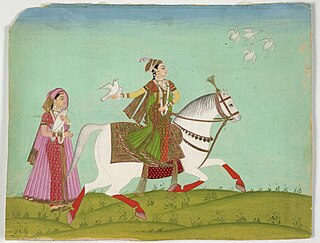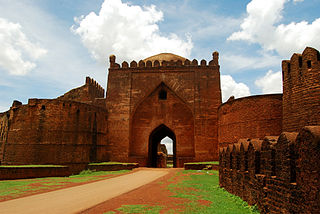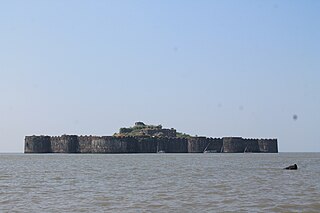Related Research Articles

Bajirao I also known as Bajirao the Great, was the 7th Peshwa of the Maratha Empire. He after Shivaji, is considered to be the most charismatic and dynamic leader in Maratha history. He was just twenty years old and already had a reputation for rapid decisions and a passion for military adventure.

Sambhaji, also known as Shambhuraje was the second Chhatrapati of the Maratha Empire, ruling from 1681 to 1689. He was the eldest son of Shivaji, the founder of the Maratha Empire. Sambhaji's rule was largely shaped by the ongoing wars between the Maratha Empire and the Mughal Empire, as well as other neighbouring powers such as the Abyssinians of Janjira, Wadiyars of Mysore and the Portuguese Empire in Goa. After Sambhaji's execution by Aurangzeb, his brother Rajaram I succeeded him as the next Chhatrapati and continued the Mughal–Maratha Wars.

Muslim period in the Indian subcontinent is conventionally said to have started in 712, after the conquest of Sindh and Multan by the Umayyad Caliphate under the military command of Muhammad ibn al-Qasim. It began in the Indian subcontinent in the course of a gradual conquest. The perfunctory rule by the Ghaznavids in Punjab was followed by Ghurids, and Sultan Muhammad of Ghor is generally credited with laying the foundation of Muslim rule in Northern India.

Murud-Janjira is the local name of a famous fort and tourist spot situated on an island just off the coastal town of Murud, in the Raigad district of Maharashtra, India. Malik Ambar is credited with the construction of the Janjira Fort in the Murud Area of present-day Maharashtra India. After its construction in 1567 AD, the fort was key to the Sidis withstanding various invasion attempts by the Marathas, Mughals, and Portuguese to capture Janjira.

Malik Ambar was a military leader who served as the Peshwa of the Ahmadnagar Sultanate in the Deccan region of India.

Joanna Nobilis Sombre, popularly known as Begum Samru, a convert Catholic Christian started her career as a nautch (dancing) girl in 18th century India, and eventually became the ruler of Sardhana, a small principality near Meerut. She was the head of a professionally trained mercenary army, inherited from her European mercenary husband, Walter Reinhardt Sombre. This mercenary army consisted of Europeans and Indians. She is also regarded as the only Catholic ruler in India, as she ruled the principality of Sardhana in 18th- and 19th-century India.
Murud is a town and a municipal council in Raigad district in the Indian state of Maharashtra. Situated at a distance of 150 km (93 mi) from Mumbai, Murud is a tourist destination. The Palace of Nawab is located in Murud. The palace was built in 1885 for administration purposes. The palace is still owned by the descendants of the Nawab and is a private property.

Sultana Chand Bibi was an Indian ruler and warrior. She acted as the Regent of Bijapur Sultanate during the minority of Ibrahim Adil Shah II in 1580-1590, and regent of Ahmednagar Sultanate during the minority of her great nephew Bahadur Shah in 1595-1600. Chand Bibi is best known for defending Ahmednagar against the Mughal forces of Emperor Akbar in 1595.

Jamal ud-Din Yaqut was an African Siddi slave-turned-nobleman who was a close confidant of Razia Sultana, the first and only female monarch of the Delhi Sultanate in India. Yakut was the puppet of Razia Sultan's stepmother but after sometime he became a trustworthy soldier of the Delhi Sultanate. Razia Sultana's patronage made him an influential member of the court, provoking racial antagonism amongst the nobles and clergy, who were both primarily Turkic and already resentful of the rule of a female monarchy.
Qasim Yakut Khan also known as Yakut Shaikhji, Yakub Khan and Sidi Yaqub was a naval Admiral and administrator of Janjira Fort who first served under Bijapur Sultanate and later under the Mughal Empire.

The Sultanate of Ahmednagar or the Nizam Shahi Sultanate was a late medieval Indian Muslim kingdom located in the northwestern Deccan, between the sultanates of Gujarat and Bijapur, ruled by the Nizam Shahi or Bahri dynasty. It was established when Malik Ahmed, the Bahmani governor of Junnar after defeating the Bahmani army led by general Jahangir Khan on 28 May 1490 declared independence and established the Nizam Shahi dynasty of the Sultanate of Ahmednagar.

Afro-Asians are African communities that have been living in the Indian subcontinent for centuries and have settled in countries such as India, Pakistan, and Sri Lanka.

The Army of the Mughal Empire was the force by which the Mughal emperors established their empire in the 16th century and expanded it to its greatest extent at the beginning of the 18th century. Although its origins, like the Mughals themselves, were in the cavalry-based armies of central Asia, its essential form and structure was established by the empire's third emperor, Akbar. The regular forces mainly recruited and fielded by Mansabdar officers.

Janjira State was a princely state in India during the British Raj. Its rulers were a Siddi dynasty of Habesha descent and the state was under the suzerainty of the Bombay Presidency.

Deccani architecture, particularly the architecture of the Bahmani and Deccan Sultanates, is the architecture of the Deccan Plateau, and is a regional variant of Indo-Islamic architecture. It was influenced by the styles of the Delhi Sultanate and later Mughal architecture, but sometimes also influenced from Persia and Central Asia. Hindu temple architecture in the same areas had very different styles.

The Maratha Navy was the naval wing of the armed forces of the Maratha Empire, which existed from around the mid-17th century to the mid-18th century in the Indian subcontinent.

The Raja Ram Rao Patil or Itbarrao Koli was an Admiral of the Ahmadnagar Navy and Koli ruler of Janjira. Patil built and fortified the Janjira Island.

Islam is the second largest religion in Maharashtra, India, comprising 12,971,152 people which is 11.54% of the population. Muslims are largely concentrated in urban areas of the state, especially in Mumbai and the Marathwada region. There are several groups of Muslims in Maharashtra: Marathi and Konkani Muslims, whose native language is various dialects of Marathi and Konkani, Dakhni Muslims, whose native language is Dakhni Urdu, and more recent Urdu-speaking migrants from North India.

The Siege of Janjira was a military campaign undertaken by the Maratha Empire, commanded by Sambhaji, the second Maratha ruler, against the Siddis of Janjira in January 1682. The Maratha forces, led by Sambhaji, withdrew from Janjira to the Konkan region in response to Mughal attacks, leaving a contingent behind under the command of Dadaji Raghunath Deshpande. Despite their efforts, the Marathas were unable to capture the fort, and the Siddis pursued the retreating forces, plundering Maratha territories.

The Shivaji's invasions of Janjira were a series of military campaigns launched by the first Maratha ruler, Shivaji, against the Abyssinian rulers of the sea fortress of Janjira named Siddis between 1661 and 1676. The Marathas attacked the Janjira fort annually, and during the final siege of 1676, the Maratha Peshwa Moropant faced a counterattack by the Siddis, forcing the Marathas to retreat with heavy casualties.
References
- Dalrymple, William (2006). The Last Mughal. Viking Penguin. ISBN 978-0-670-99925-5..
- Dalrymple, William (2004). White Mughals: love and betrayal in eighteenth-century India. Penguin Books. ISBN 978-0-14-200412-8..
- Disney, Anthony R. (1995). Historiography of Europeans in Africa and Asia, 1450–1800. Variorum. ISBN 978-0-86078-503-3..
- Prabhu, Alan Machado (1999). Sarasvati's Children: A History of the Mangalorean Christians. I.J.A. Publications. ISBN 978-81-86778-25-8..